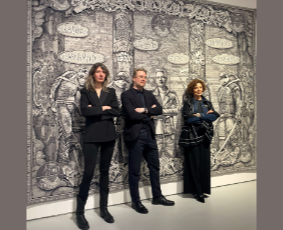“Bodies, Grids, and Ecstasy”
Exhibition @ KAI 10 | Arthena Foundation
Margret Eicher and Lena Schramm in Conversation with Dr. Sebastian Baden, moderated by Ludwig Seyfarth
(This post also appears—in two parts and slightly different form—at my Instagram account betweendrafts.)
This is the second panel discussion for this exhibition.
The first conversation, with Margret Eicher, revolved around the techniques and production processes of her «tapisserie» work, and her simultaneous use and subversion via “CopyCollage” of this art form’s rhetoric that had marked and communicated courtly power in the 16th century.
For her exhibit »Göttliche Liebe« (2011), which juxtaposes queer love with Christian core motifs, this subversion works exceptionally well. »Agent Assange« (2020), however, challenges this concept. Here, Assange is depicted as a youthful hero with the TMNT as his bodyguards, who rises from the underground to confront corrupt and malevolent state powers.
Yet, while bringing unspeakable atrocities to light through leaks like Collateral Murder and the Guantanamo Files, Assange himself turned out to be a terrible human being. His pro-Trump stance aligned him with the most deplorable misogynistic, anti-queer, and antisemitic elements, up to and including his schmooze with GamerGate as a critically important manufactured campaign for the rise of the “alt-right.” From this perspective, the work’s topic seems to usurp the rhetorical power the work itself supposedly subverts, with »Agent Assange« becoming reminiscent of the imagery of GamerGaters who loved to depict themselves as “rising up” from the social underground against the “elites,” up to and including as “tank men” who stand strong against the rolling tanks of feminism, queer folks, brown people, Jews, and the “lying press.”
Once a die-hard New Critic, postmodernism and deconstruction taught me that artistic intention does have its place—to analyze, e.g., how a work of art does what it does by supporting, enhancing, or undermining these intentions. The rhetoric of power of “Agent Assange,” which flips back and forth like an ambiguous image, would make for a rich discussion with the artist; for which, alas, this event wasn’t the time and place.
The second conversation, with Lena Schramm, revolved around the rhetorical power of success as co-opted by the manufacturers of ecstasy pills. The paintings that depict these pills—mostly pills that exist or did exist in the wild, some creatively invented by the artist—are presented and framed in subtly ungrid-y grids with the occasional blank space and paint drip. These come together with an actual book, a make-believe dictionary that lists 570 (572 with variants) forms of ecstasy pills from the 1990s until today.
Everything about Schramm’s series of paintings and the book feels postmodern, from the artist’s co-optation of the manufacturers’ co-optation of logos and brands and emblems and icons and cartoon characters and popular personalities for a psychedelic/recreational drug to a presentation that juxtaposes tangibly thick paint and rough palette knife strokes with a lexicography in the tradition of exhaustive but always already incomplete lists that postmodern writers like John Barth or Thomas Pynchon loved to employ. (Hip-hop culture’s rap lyrics also love lists, and there might be a connection there.)
Cyberpunk motifs come to mind, certainly, as do Fredric Jameson’s essays on late capitalism. But the playfulness of classical postmodernist art in general and postmodern literature in particular seems to have the right of way after all, in a thought-provoking and entertaining good way.
________________
All Art Event Reviews
If you have something valuable to add or some interesting point to discuss, I’ll be looking forward to meeting you at Mastodon!

